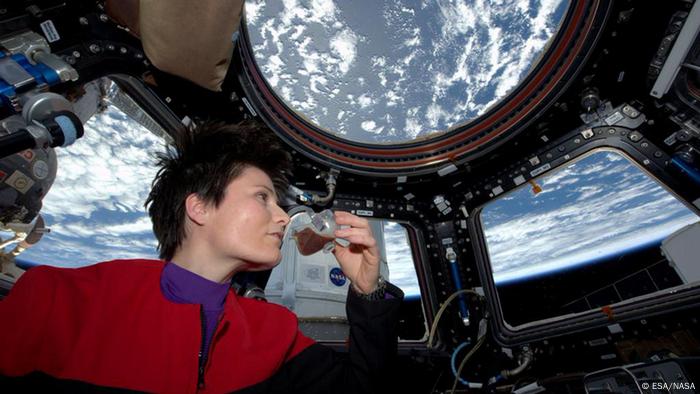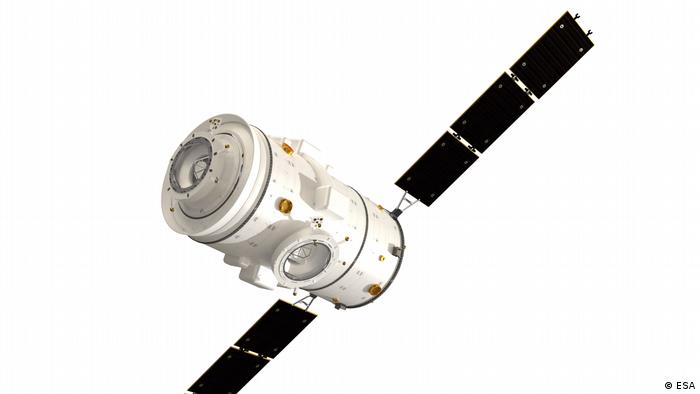ISS: Astronaut Cristoforetti readies to return 'home'
In 2022, ESA astronaut Samantha Cristoforetti will fly to the International Space Station for a second time. She calls it her "home away from home," but many things there have changed since her first visit.

Samantha Cristoforetti is looking forward to more coffee breaks at the ISS next year
ESPRESSO IN SPACE
"It is a great pleasure for me to announce Samantha's coming space mission," said Josef Aschbacher, the new director general of the European Space Agency (ESA), as he opened a press conference on March 3.
ESA astronaut Samantha Cristoforetti is scheduled to go back to the International Space Station (ISS) for her second stay in the spring of 2022, following her two colleagues Thomas Pesquet and Matthias Maurer, who will set off for the ISS in April and October 2021 respectively.
Cristoforetti herself is delighted. "Not surprisingly, it was a feeling of extreme joy and gratefulness for this opportunity. As I've mentioned before, I had the amazing opportunity the past few years to grow as an astronaut. But we have this tendency of wanting to go back to space as soon as possible," she admitted.
Freshly brewed ISSpresso
For Cristoforetti, it will be a return to her "home away from home," as she likes to call the ISS. The Italian astronaut has indeed already spent a remarkable amount of time in orbit. From fall 2014 to spring 2015, she was at the station for 200 days working as flight engineer for the mission Futura, the second-longest period spent in space by an ESA astronaut. Her colleague and astronaut classmate Luca Parmitano is the only one to have topped that record — by just a single day.
The world record for the longest single spaceflight is held the Russian cosmonaut Valeri Polyakov with 437 days. But his compatriot Gennady Padalka has spent more time in space overall than anyone else, totting up a record total of 878 days when all his five missions are combined.
During her first stay at the ISS, Cristoforetti conducted many experiments, most of them related to biology and genetics. In one of them, she looked at how mammalian immune cells reacted to different levels of microgravity. The data drawn from this experiment showed that it takes only a few seconds for these cells to adapt to weightlessness.
But one experiment in particular caught people's attention during her stay: she was able to come up with the first freshly brewed espresso on the ISS.
Commercial support
This time round, many things will have changed. "The positive side of having waited all these years is that the mission will have some different aspects to it. So it's kind of exciting to fly a new spaceship," said Cristoforetti, referring to the new commercial spacecraft from the US that will replace the Russian Soyuz spacecraft for the three next ESA missions to the ISS.
It still has to be decided which spacecraft will take Cristoforetti: Space-X's Dragon or Boeing's Starliner. The exact date for her flight has also not been confirmed yet.
Recently refurbished
"The space station has been undergoing this midlife upgrade for some time. New hardware up there, new operations, a lot more interesting experiments," said Cristoforetti. One thing she is particularly looking forward to is a new piece of equipment already waiting on board the ISS to go into operation in the space laboratory Columbus: a 3D printer to print metal in space.

ESA's astronaut class from 2009: Cristoforetti and her colleague Pesquet
(on her right) will fly to the ISS in 2022 and 2021
And the ISS has its own space balcony now: Bartolomeo, a platform newly installed outside the Columbus module that will allow private companies to carry out experiments under space conditions.
Feet on the ground, eyes on the stars
Although Cristoforetti has spent the past few years back with her feet on solid ground, her gaze has been set on goals even further away than the ISS, as preparations rev up to put people on the moon once more.
"It's been exciting years since I came back. I am very grateful actually that I had the chance of growing professionally and to give something back from my experience as an astronaut," she said. For example, she has headed ESA's Spaceship EAC initiative, where she has mentored students tackling the technological challenges involved in moon missions. The plan is for such missions to be launched not from Earth, but from the Lunar Orbital Platform-Gateway, a space station orbiting the moon projected to be built within the next nine years.
As an experienced astronaut, Cristoforetti knows exactly what a person needs to feel at home in space. For this reason, she was selected to be the crew representative for the future residents of this lunar station.
"I was able to give my contribution from the perspective of an astronaut. And I am especially excited about that because Italy is leading the designing and manufacturing of these modules for ESA," she said, referring to the I-Hab modules that will be the main living quarters for future astronauts at the Gateway.

This artist's impression shows the planned I-Hab module
for astronauts working at the Lunar Gateway
Over the moon
Who these astronauts may be has been a mystery since 2009, when the last official class of astronauts, to which Cristoforetti belonged, was chosen by ESA. But that is about to change: From March 2021 until April 2021, ESA is once again taking applications from aspiring astronauts.
"Samantha and her colleagues are highly qualified and very young and there is no intention to not have them in space anymore," said ESA Director General Josef Aschbacher. "But, of course, we need to renew our astronaut class and eventually send astronauts beyond the ISS toward the moon. And eventually, in the next decade, even further, to Mars." There are three places already reserved for European astronauts to fly to the Lunar Gateway within this decade.
For now, Cristoforetti is returning to the ISS, where she will most likely stay for the usual six-month stint. Does she have any more premieres in mind on the lines of that first espresso in space? "I don't know, I have a few ideas. But that would be a little bit early to give it away," she said.

















 The remains of the upper and lower jaw of a Neanderthal from the Spy Cave in Belgium Patrick SEMAL RBINS/AFP
The remains of the upper and lower jaw of a Neanderthal from the Spy Cave in Belgium Patrick SEMAL RBINS/AFP



 Spain has a thriving feminist movement
Spain has a thriving feminist movement 
 Algerian women chant slogans during a protest in the capital Algiers against a family code they say restricts their rights
Algerian women chant slogans during a protest in the capital Algiers against a family code they say restricts their rights 
 The march took place with a heavy police presence
The march took place with a heavy police presence